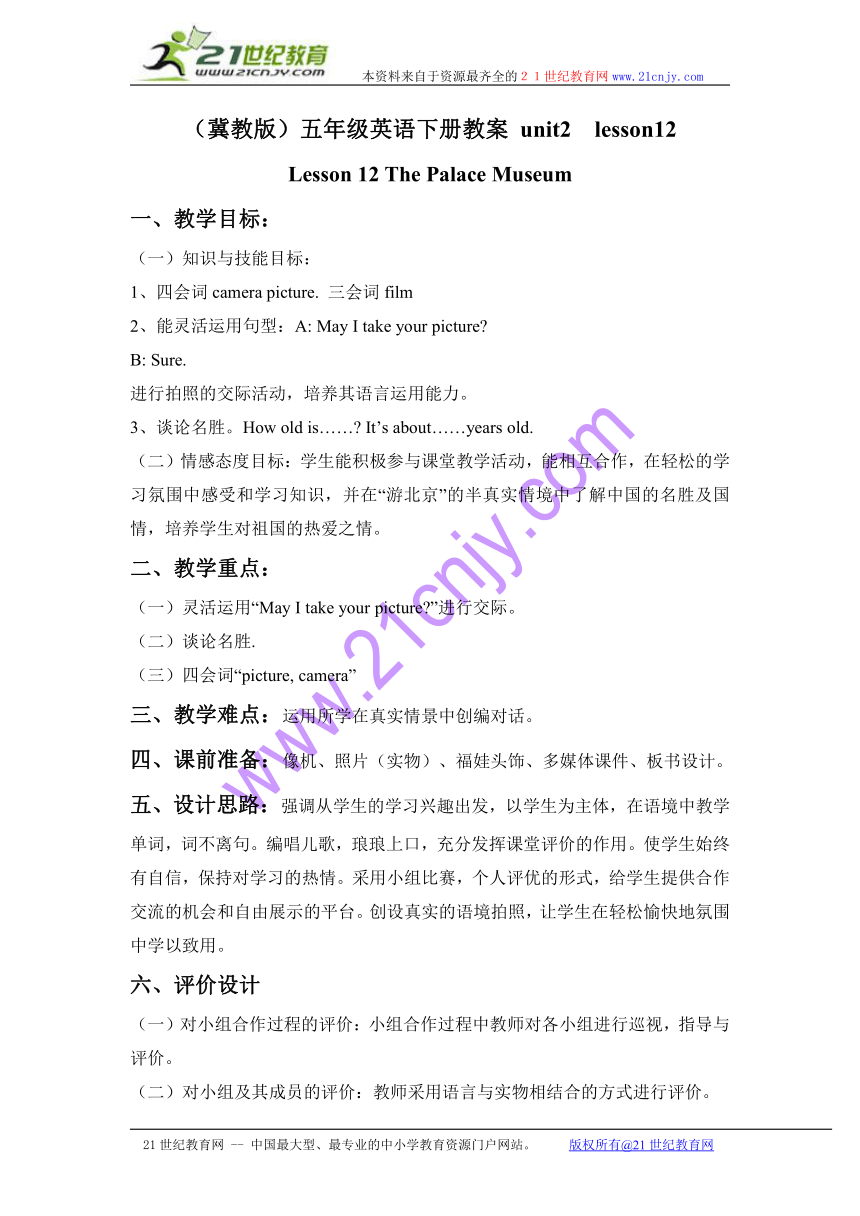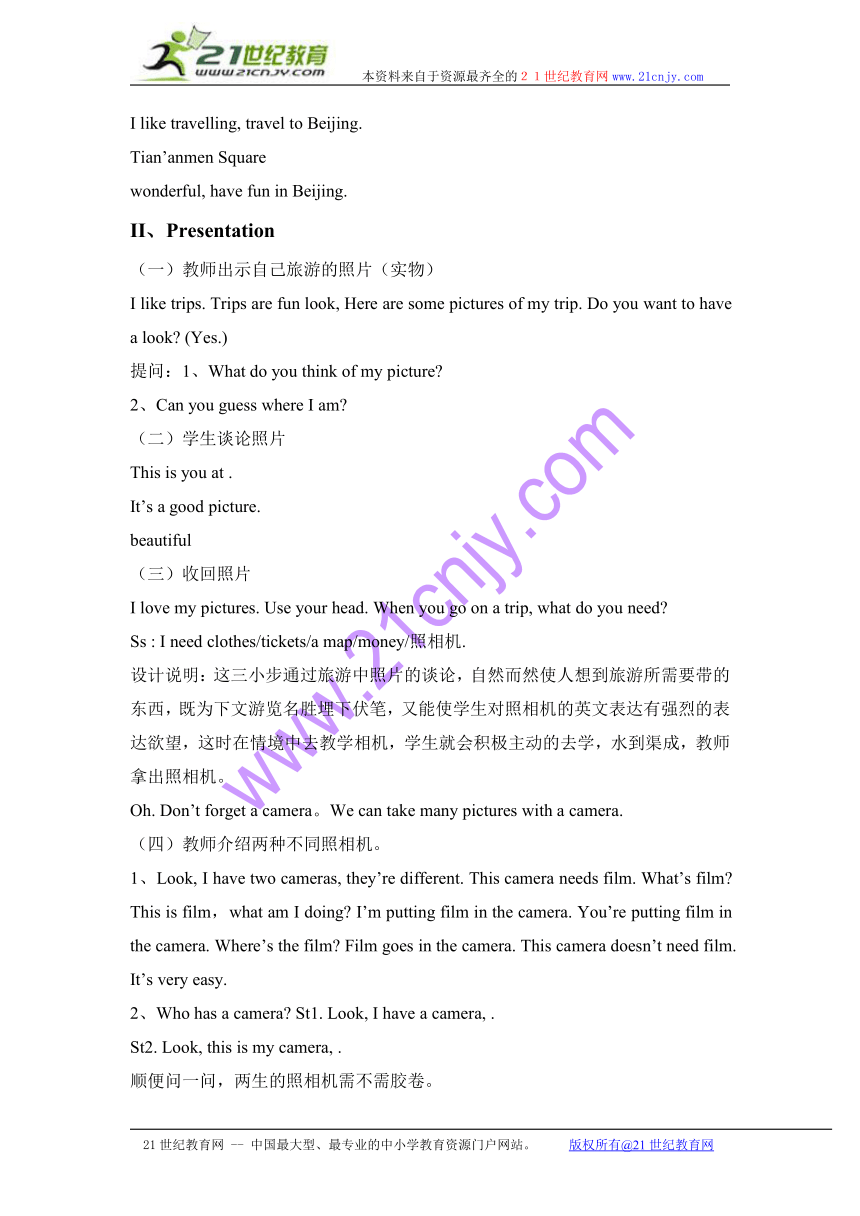五年级英语下册教案 unit2 lesson12(1)(冀教版)
文档属性
| 名称 | 五年级英语下册教案 unit2 lesson12(1)(冀教版) |  | |
| 格式 | rar | ||
| 文件大小 | 15.6KB | ||
| 资源类型 | 教案 | ||
| 版本资源 | 冀教版 | ||
| 科目 | 英语 | ||
| 更新时间 | 2010-03-05 19:20:00 | ||
图片预览



文档简介
本资料来自于资源最齐全的21世纪教育网www.21cnjy.com
(冀教版)五年级英语下册教案 unit2 lesson12
Lesson 12 The Palace Museum
一、教学目标:
(一)知识与技能目标:
1、四会词camera picture. 三会词film
2、能灵活运用句型:A: May I take your picture
B: Sure.
进行拍照的交际活动,培养其语言运用能力。
3、谈论名胜。How old is…… It’s about……years old.
(二)情感态度目标:学生能积极参与课堂教学活动,能相互合作,在轻松的学习氛围中感受和学习知识,并在“游北京”的半真实情境中了解中国的名胜及国情,培养学生对祖国的热爱之情。
二、教学重点:
(一)灵活运用“May I take your picture ”进行交际。
(二)谈论名胜.
(三)四会词“picture, camera”
三、教学难点:运用所学在真实情景中创编对话。
四、课前准备:像机、照片(实物)、福娃头饰、多媒体课件、板书设计。
五、设计思路:强调从学生的学习兴趣出发,以学生为主体,在语境中教学单词,词不离句。编唱儿歌,琅琅上口,充分发挥课堂评价的作用。使学生始终有自信,保持对学习的热情。采用小组比赛,个人评优的形式,给学生提供合作交流的机会和自由展示的平台。创设真实的语境拍照,让学生在轻松愉快地氛围中学以致用。
六、评价设计
(一)对小组合作过程的评价:小组合作过程中教师对各小组进行巡视,指导与评价。
(二)对小组及其成员的评价:教师采用语言与实物相结合的方式进行评价。
(三)学生互评:以相互鼓励为主。
七、板书设计:
Lesson 12 The Palace Museum
camera
picture
film
A: May I take your picture B: Sure. A: It’s very easy. It’s very hard.
Team A ______________________________________
Team B ______________________________________
八、教学过程:
I、Warming – up.
(一)Greetings. T : Good morning, everyone!
Ss : Good morning, Miss Zhang!
T : How are you today
Ss : Fine, thanks. And you
T : I’m so well.
(二)Sing a song. I love trips. Do you love trips (Me,too.) Great! We’re the same. Let’s sing together, please follow me! 多媒体出示乘车旅游图片,师生同唱。
设计说明:师生问候及师生共唱英文歌曲,并随之而动,创设了师生共同参与的和谐的学习氛围,该活动能积极地起到热身的作用,歌词如下:
travelling, travelling, I like travelling.
go on a trip to Beijing. Beautiful Beijing.
I like travelling, travel to Beijing.
Tian’anmen Square
wonderful, have fun in Beijing.
II、Presentation
(一)教师出示自己旅游的照片(实物)
I like trips. Trips are fun look, Here are some pictures of my trip. Do you want to have a look (Yes.)
提问:1、What do you think of my picture
2、Can you guess where I am
(二)学生谈论照片
This is you at .
It’s a good picture.
beautiful
(三)收回照片
I love my pictures. Use your head. When you go on a trip, what do you need
Ss : I need clothes/tickets/a map/money/照相机.
设计说明:这三小步通过旅游中照片的谈论,自然而然使人想到旅游所需要带的东西,既为下文游览名胜埋下伏笔,又能使学生对照相机的英文表达有强烈的表达欲望,这时在情境中去教学相机,学生就会积极主动的去学,水到渠成,教师拿出照相机。
Oh. Don’t forget a camera。We can take many pictures with a camera.
(四)教师介绍两种不同照相机。
1、Look, I have two cameras, they’re different. This camera needs film. What’s film This is film,what am I doing I’m putting film in the camera. You’re putting film in the camera. Where’s the film Film goes in the camera. This camera doesn’t need film. It’s very easy.
2、Who has a camera St1. Look, I have a camera, .
St2. Look, this is my camera, .
顺便问一问,两生的照相机需不需胶卷。
设计说明:让学生介绍照相机,发挥其积极主动性,在教学过程中有意识训练学生的应用思维能力。过渡到拍照:Time to take pictures! Can you Today let’s have a try.
(五)拍照
1、示范
A: Look at.she is a pretty girl.
May I take yourpicture
B: Sure.
A: Oh, it’s very easy.
A: Can you take a picture for me B: Sure. A: Is it easy or hard
A: Do you want to take a picture for your friend B: Yes, I do. May I take …… C: Sure.
设计说明:把示范拍的照片及时反映在屏幕上,给人耳目一新的感觉,在教师引导下,在情境中突破本课重点,且激发学习兴趣,热情高涨。
2、另一生学拍
Anybody else Who’d like to have a try (Me)或许不会拍照。
St1: May I take a picture
St2: Sure.
St1: Oh, no, it’s very hard.
T : Don’t worry, I can help you.
设计说明:在第一个学生拍完后,全班给予集体评价,这样在好奇心得到充分肯定的驱使下,学生们会跃跃欲试,整体看来,学生在情境中学语言、运用语言,手脑并用,既学会了拍照,又学会了语言。
Drill, 小组游戏:
1)比快。Cameras are easy. Who else Let’s play together. Pass the camera one by one, and take a picture for your friend. When you finish, say Bingo. Let’s see which group goes more quickly.
设计说明:小组拍照“比快”,既训练句型,又促进了学生合作交流,对获胜者,师生共同激励。
2)拍照比好。“Go Go stop”游戏,为学生提供自主学习和相互交流的机会,同时还为学生创造了自我的空间。
Now, you can take pictures quickly. Cameras are fun, do you want to play a game? Let’s play“Go Go stop”.
Let’s see their pictures! Who is better 让学生自评。
3)大屏幕出示歌词,学唱。
Camera, Camera, Camera, Camera. It’s fun. It’s fun.
Do you like it Do you like it Yes, I do. Yes, I do.
Take a picture, Take a picture, Yes, I can. Yes, I can.
It’s very. It’s very. Yes, I can. Yes, I can.
设计说明:轻松愉快的巩固所学。
过渡:Now I have a new idea I want to go on a trip with a camera. Let’s go on a trip! Where Maybe it’s Beijing. Why We know Beijing is holding the Olympic Games. Are you excited Let’s cheer:“Come on, China! Come on. Beijing!”Beijing is so great. Let’s go!OK
III、Practice
(一)Here we are! Welcome to Beijing!
I’m happy to show you around Beijing.
A: Let’s go on a trip to the Palace Museum.
B: Great.
A: It’s very old and beautiful isn’t it
B: Yes. How old is it
A: It’s about 500 years old.
B: That’s very old. let’s take a picture.
A: Good idea. Can you take a picture for us?
拍完后:Are you having fun Anywhere else let’s go to .
设计,火娃先示范表演,其他福娃也走下去当导游,在谈论名胜的背景下,实拍照片。这一节课亮点、高潮即在于此。语言不拘泥于教材,培养学生的创新能力。
(二)回到课本:
1、听录音,看图片,回答问题
We are having fun in Beijing. (Danny, Jenny and Li Ming are on a trip in Beijing. What about them )
Look、listen and answer me my questions:
1) Where are they
2) What’s the matter with Danny
设计说明:通过训练学生的观察力、听力、理解能力。了解对话大意,并检查所学知识的掌握情况。
2、分角色读,(四个角色)(教师旁白)师生共读,给录像配音,调动学生读书的积极性,有助于学生的合作交流,促进学生的语感。
IV、Summarize
(一)We have a good time. We should thank the lucky babies. Which one do you like I like .
设计说明:小结本课知识重点,动静结合,加深印象。
(二)I have some pictures. Do you have pictures of your trip Would you like to talk about it for us.(找两、三名即可)。Sure.
学生谈论自己的照片,正是本课的升华,以教师介绍照片开始,以学生谈论照片结束,中间以拍照活动为线索,前后呼应,环环紧扣,浑然一体。
21世纪教育网 -- 中国最大型、最专业的中小学教育资源门户网站。 版权所有@21世纪教育网
(冀教版)五年级英语下册教案 unit2 lesson12
Lesson 12 The Palace Museum
一、教学目标:
(一)知识与技能目标:
1、四会词camera picture. 三会词film
2、能灵活运用句型:A: May I take your picture
B: Sure.
进行拍照的交际活动,培养其语言运用能力。
3、谈论名胜。How old is…… It’s about……years old.
(二)情感态度目标:学生能积极参与课堂教学活动,能相互合作,在轻松的学习氛围中感受和学习知识,并在“游北京”的半真实情境中了解中国的名胜及国情,培养学生对祖国的热爱之情。
二、教学重点:
(一)灵活运用“May I take your picture ”进行交际。
(二)谈论名胜.
(三)四会词“picture, camera”
三、教学难点:运用所学在真实情景中创编对话。
四、课前准备:像机、照片(实物)、福娃头饰、多媒体课件、板书设计。
五、设计思路:强调从学生的学习兴趣出发,以学生为主体,在语境中教学单词,词不离句。编唱儿歌,琅琅上口,充分发挥课堂评价的作用。使学生始终有自信,保持对学习的热情。采用小组比赛,个人评优的形式,给学生提供合作交流的机会和自由展示的平台。创设真实的语境拍照,让学生在轻松愉快地氛围中学以致用。
六、评价设计
(一)对小组合作过程的评价:小组合作过程中教师对各小组进行巡视,指导与评价。
(二)对小组及其成员的评价:教师采用语言与实物相结合的方式进行评价。
(三)学生互评:以相互鼓励为主。
七、板书设计:
Lesson 12 The Palace Museum
camera
picture
film
A: May I take your picture B: Sure. A: It’s very easy. It’s very hard.
Team A ______________________________________
Team B ______________________________________
八、教学过程:
I、Warming – up.
(一)Greetings. T : Good morning, everyone!
Ss : Good morning, Miss Zhang!
T : How are you today
Ss : Fine, thanks. And you
T : I’m so well.
(二)Sing a song. I love trips. Do you love trips (Me,too.) Great! We’re the same. Let’s sing together, please follow me! 多媒体出示乘车旅游图片,师生同唱。
设计说明:师生问候及师生共唱英文歌曲,并随之而动,创设了师生共同参与的和谐的学习氛围,该活动能积极地起到热身的作用,歌词如下:
travelling, travelling, I like travelling.
go on a trip to Beijing. Beautiful Beijing.
I like travelling, travel to Beijing.
Tian’anmen Square
wonderful, have fun in Beijing.
II、Presentation
(一)教师出示自己旅游的照片(实物)
I like trips. Trips are fun look, Here are some pictures of my trip. Do you want to have a look (Yes.)
提问:1、What do you think of my picture
2、Can you guess where I am
(二)学生谈论照片
This is you at .
It’s a good picture.
beautiful
(三)收回照片
I love my pictures. Use your head. When you go on a trip, what do you need
Ss : I need clothes/tickets/a map/money/照相机.
设计说明:这三小步通过旅游中照片的谈论,自然而然使人想到旅游所需要带的东西,既为下文游览名胜埋下伏笔,又能使学生对照相机的英文表达有强烈的表达欲望,这时在情境中去教学相机,学生就会积极主动的去学,水到渠成,教师拿出照相机。
Oh. Don’t forget a camera。We can take many pictures with a camera.
(四)教师介绍两种不同照相机。
1、Look, I have two cameras, they’re different. This camera needs film. What’s film This is film,what am I doing I’m putting film in the camera. You’re putting film in the camera. Where’s the film Film goes in the camera. This camera doesn’t need film. It’s very easy.
2、Who has a camera St1. Look, I have a camera, .
St2. Look, this is my camera, .
顺便问一问,两生的照相机需不需胶卷。
设计说明:让学生介绍照相机,发挥其积极主动性,在教学过程中有意识训练学生的应用思维能力。过渡到拍照:Time to take pictures! Can you Today let’s have a try.
(五)拍照
1、示范
A: Look at.she is a pretty girl.
May I take yourpicture
B: Sure.
A: Oh, it’s very easy.
A: Can you take a picture for me B: Sure. A: Is it easy or hard
A: Do you want to take a picture for your friend B: Yes, I do. May I take …… C: Sure.
设计说明:把示范拍的照片及时反映在屏幕上,给人耳目一新的感觉,在教师引导下,在情境中突破本课重点,且激发学习兴趣,热情高涨。
2、另一生学拍
Anybody else Who’d like to have a try (Me)或许不会拍照。
St1: May I take a picture
St2: Sure.
St1: Oh, no, it’s very hard.
T : Don’t worry, I can help you.
设计说明:在第一个学生拍完后,全班给予集体评价,这样在好奇心得到充分肯定的驱使下,学生们会跃跃欲试,整体看来,学生在情境中学语言、运用语言,手脑并用,既学会了拍照,又学会了语言。
Drill, 小组游戏:
1)比快。Cameras are easy. Who else Let’s play together. Pass the camera one by one, and take a picture for your friend. When you finish, say Bingo. Let’s see which group goes more quickly.
设计说明:小组拍照“比快”,既训练句型,又促进了学生合作交流,对获胜者,师生共同激励。
2)拍照比好。“Go Go stop”游戏,为学生提供自主学习和相互交流的机会,同时还为学生创造了自我的空间。
Now, you can take pictures quickly. Cameras are fun, do you want to play a game? Let’s play“Go Go stop”.
Let’s see their pictures! Who is better 让学生自评。
3)大屏幕出示歌词,学唱。
Camera, Camera, Camera, Camera. It’s fun. It’s fun.
Do you like it Do you like it Yes, I do. Yes, I do.
Take a picture, Take a picture, Yes, I can. Yes, I can.
It’s very. It’s very. Yes, I can. Yes, I can.
设计说明:轻松愉快的巩固所学。
过渡:Now I have a new idea I want to go on a trip with a camera. Let’s go on a trip! Where Maybe it’s Beijing. Why We know Beijing is holding the Olympic Games. Are you excited Let’s cheer:“Come on, China! Come on. Beijing!”Beijing is so great. Let’s go!OK
III、Practice
(一)Here we are! Welcome to Beijing!
I’m happy to show you around Beijing.
A: Let’s go on a trip to the Palace Museum.
B: Great.
A: It’s very old and beautiful isn’t it
B: Yes. How old is it
A: It’s about 500 years old.
B: That’s very old. let’s take a picture.
A: Good idea. Can you take a picture for us?
拍完后:Are you having fun Anywhere else let’s go to .
设计,火娃先示范表演,其他福娃也走下去当导游,在谈论名胜的背景下,实拍照片。这一节课亮点、高潮即在于此。语言不拘泥于教材,培养学生的创新能力。
(二)回到课本:
1、听录音,看图片,回答问题
We are having fun in Beijing. (Danny, Jenny and Li Ming are on a trip in Beijing. What about them )
Look、listen and answer me my questions:
1) Where are they
2) What’s the matter with Danny
设计说明:通过训练学生的观察力、听力、理解能力。了解对话大意,并检查所学知识的掌握情况。
2、分角色读,(四个角色)(教师旁白)师生共读,给录像配音,调动学生读书的积极性,有助于学生的合作交流,促进学生的语感。
IV、Summarize
(一)We have a good time. We should thank the lucky babies. Which one do you like I like .
设计说明:小结本课知识重点,动静结合,加深印象。
(二)I have some pictures. Do you have pictures of your trip Would you like to talk about it for us.(找两、三名即可)。Sure.
学生谈论自己的照片,正是本课的升华,以教师介绍照片开始,以学生谈论照片结束,中间以拍照活动为线索,前后呼应,环环紧扣,浑然一体。
21世纪教育网 -- 中国最大型、最专业的中小学教育资源门户网站。 版权所有@21世纪教育网
同课章节目录
- Unit 1 Going to Beijing
- Lesson 1 I Am Excited!
- Lesson 2 What Are You Doing?
- Lesson 3 Who Is Singing?
- Lesson 4 Who Is Hungry?
- Lesson 5 What Are They Doing?
- Lesson 6 Danny Is Lost!
- Again, Please!
- Unit 2 In Beijing
- Lesson 7 Arriving in Beijing
- Lesson 8 Tian'anmem Square
- Lesson 9 The Palace Museum
- Lesson 10 The Great Wall
- Lesson 11 Shopping in Beijing
- Lesson 12 A Visit to the Great Wall
- Again, Please!
- Unit 3 Writing Home
- Lesson 13 Let's Buy Postcards!
- Lesson 14 Jenny Writes a Postcard
- Lesson 15 Sending the Postcards
- Lesson 16 An Email Is Fast
- Lesson 17 Danny's Email
- Lesson 18 Little Zeke Sends an Email
- Unit 4 Did You Have a Nice Trip?
- Lesson 19 Li Ming Goes Home
- Lesson 20 Jenny Goes Home
- Lesson 21 Look at the Photos!
- Lesson 22 Gifts for Everyone
- Lesson 23 An Email from Li Ming
- Lesson 24 A Gift for Little Zeke
